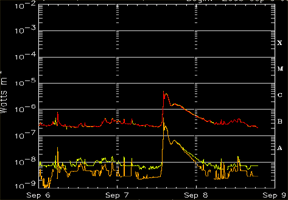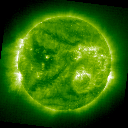



|
Solar Flares Solar flares are short-term outbursts on the sun, caused by the sudden release of energy stored in twisted magnetic fields in the solar atmosphere. Flares are more contained than coronal mass ejections but still release up to 10 25 joules of energy—the energy equivalent of ten million volcanic eruptions. They can last just a few minutes or up to several hours. Flares occur in active regions, areas on the sun where the magnetic fields are very strong. In this ultraviolet light image of the sun on the right, the active regions stand out as bright spots or clusters of spots. (In visible light images of the sun, the dark spots you see—called sunspots—are active regions.) By the way, the green color isn’t real: It’s the color chosen to represent ultraviolet light, which is invisible to our eyes. Look at the current image of the sun on the lower right. Do you see any bright spots or clusters? These are active regions, sites for possible solar flares.
Solar flares fling tremendous amounts of energy
into space, including high-energy particles (protons, electrons,
and atomic nuclei) and electromagnetic radiation ranging from gamma
rays and X-rays to radio waves. Radiation travels at the breakneck
speed of light—186,000 miles/second (300,000 kilometers/second)—so
X-rays, gamma rays, and radio waves are the first evidence of a
flare to reach the earth, which happens in about 8 minutes. Particles
travel more slowly, taking anywhere from about 30 minutes (for
higher energy particles) to several days to reach the earth. When
electromagnetic radiation and particles from flares do reach the
earth, they can cause
space
weather effects
, including disruptions in communications.
|
|
|
© Exploratorium


